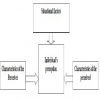Home | ARTS | Management Concepts & Organisational Behaviour
|
Internal Factors Influencing Selection - Perception And Learning
Management Concepts & Organisational Behaviour - Perception And Learning
Internal Factors Influencing Selection - Perception And Learning
Posted On :
Internal factors influencing selection of stimuli are personality, learning, and motivation. They are explained below.
Internal
Factors Influencing Selection
Internal factors influencing selection of stimuli are personality, learning, and motivation. They are explained below.
It cannot be disputed that personality has a significant impact on what and how people perceive. The various personality dimensions influence the perceptual process. A conscientious person is likely to pay greater attention to external environmental stimuli than a less conscientious person who is likely to be careless, impulsive and irresponsible. On the other hand, conscientious people tend to organize their perceptions into clear categories, receive information quickly and in an organized manner. They are careful and methodical in their perceptual selection and organization.
Perceptual selection is also affected by learning. Learning determines the development of perceptual sets. Perceptual set means the expectation of particular interpretation based on past experience with the same object. This is also known as cognitive awareness by which the minds organizes information and form images and compare them with previous exposures to similar stimuli. In organizations employees’ experiences are influenced by their perception very much. In making decisions, managers are also influenced by their functional background. However, it is necessary for managers to rise above their own experiences and be able to solve the problems in an appropriate way. Individual differences lead to perceptual bias. This bias can be overcome through education and experience.
Motivation also plays an important role in influencing the process of perception. For example, a hungry person is likely to be sensitive to the sight or smell of food than a non hungry person. Likewise if the person is deprived of sleep, he looks for a situation in which he can have a comfortable sleep. Generally, people perceive things that help in satisfying needs and those that were found rewarding in the past. The relationship between motivation and perception is explained through Collenyannia Principle which states that people process pleasant events more efficiently and accurately than the unpleasant events.
Internal factors influencing selection of stimuli are personality, learning, and motivation. They are explained below.
Personality
It cannot be disputed that personality has a significant impact on what and how people perceive. The various personality dimensions influence the perceptual process. A conscientious person is likely to pay greater attention to external environmental stimuli than a less conscientious person who is likely to be careless, impulsive and irresponsible. On the other hand, conscientious people tend to organize their perceptions into clear categories, receive information quickly and in an organized manner. They are careful and methodical in their perceptual selection and organization.
Learning
Perceptual selection is also affected by learning. Learning determines the development of perceptual sets. Perceptual set means the expectation of particular interpretation based on past experience with the same object. This is also known as cognitive awareness by which the minds organizes information and form images and compare them with previous exposures to similar stimuli. In organizations employees’ experiences are influenced by their perception very much. In making decisions, managers are also influenced by their functional background. However, it is necessary for managers to rise above their own experiences and be able to solve the problems in an appropriate way. Individual differences lead to perceptual bias. This bias can be overcome through education and experience.
Motivation
Motivation also plays an important role in influencing the process of perception. For example, a hungry person is likely to be sensitive to the sight or smell of food than a non hungry person. Likewise if the person is deprived of sleep, he looks for a situation in which he can have a comfortable sleep. Generally, people perceive things that help in satisfying needs and those that were found rewarding in the past. The relationship between motivation and perception is explained through Collenyannia Principle which states that people process pleasant events more efficiently and accurately than the unpleasant events.
Tags : Management Concepts & Organisational Behaviour - Perception And Learning
Last 30 days 2367 views














